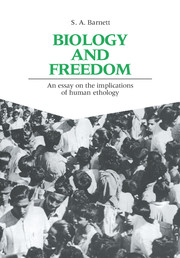Book contents
- Frontmatter
- Contents
- List of illustrations
- Preface
- Acknowledgements
- Part 1 An introduction
- Part 2 Homopugnax: the violent species
- 4 Communication and instinct
- 5 The aggression labyrinth
- Part 3 Homo egoisticus: the selfish species
- Part 4 Homo operans: the greedy species
- Part 5 Homo sapiens: the human species
- Glossary
- Notes
- References
- Name index
- Subject index
5 - The aggression labyrinth
Published online by Cambridge University Press: 04 August 2010
- Frontmatter
- Contents
- List of illustrations
- Preface
- Acknowledgements
- Part 1 An introduction
- Part 2 Homopugnax: the violent species
- 4 Communication and instinct
- 5 The aggression labyrinth
- Part 3 Homo egoisticus: the selfish species
- Part 4 Homo operans: the greedy species
- Part 5 Homo sapiens: the human species
- Glossary
- Notes
- References
- Name index
- Subject index
Summary
Why this wild strain of imagination found reception so long in polite and learned ages, it is not easy to conceive; but we cannot wonder that while readers could be procured, the authors were willing to continue it; for when a man had by practice gained some fluency of language, he had no further care than to retire to his closet, let loose his invention, and heat his mind with incredibilities; a book was thus produced without fear of criticism, without the toil of study, without knowledge of nature, or acquaintance with life.
Samuel Johnson‘We are all potential assassins’, writes P.G. Zimbardo; but, he might have added, few of us are assassins in reality. We may ask why human beings commit appalling acts of violence; the need to answer this question is behind much writing on ‘aggression’. But it is equally appropriate to ask why most of us, even in the face of provocation, are peaceable most of the time. The previous chapter disposes of attempts to find answers in ethology, but there are other obstacles to understanding. One is the vast range of phenomena put under the heading of aggression.
Meanings
It is sometimes said that aggression is difficult to define. Such a statement might be accepted if it referred to writings about activities of a single kind with indistinct boundaries. As the lists opposite show, this does not apply to aggression: the term has been used so variously, that sometimes it could be replaced by ‘behavior’ with no loss of meaning.
- Type
- Chapter
- Information
- Biology and FreedomAn Essay on the Implications of Human Ethology, pp. 56 - 76Publisher: Cambridge University PressPrint publication year: 1989



